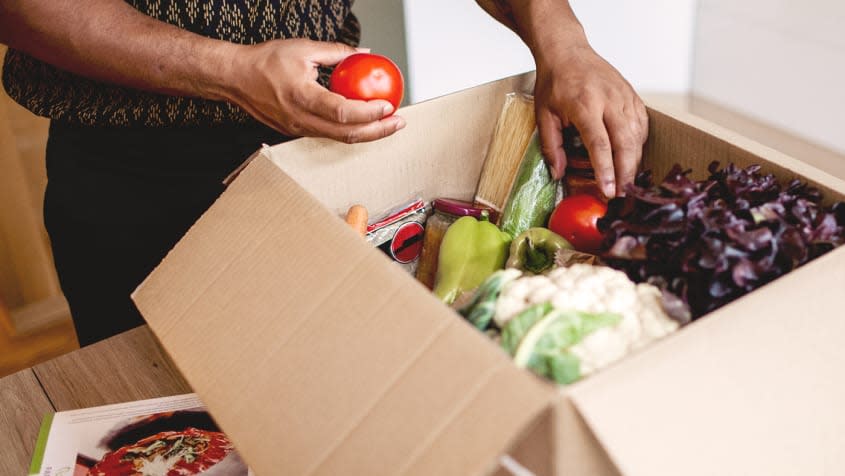Are meal kits worth it?


From HelloFresh to Blue Apron, meal kit subscription services have been popular for a while now. These kits allow you to order all of the preportioned ingredients for a quick easy-to-make meal straight to your doorstep, so you get the benefit of home-cooked food alongside the convenience of skipping grocery shopping and measuring.
According to Nerdwallet, meal kit companies often offer "dramatic discounts on their plans for new customers, including dozens of free meals, or over 50% off the full price for first-time subscribers." But after that promotional period is up, you may be left wondering: Are meal kit subscriptions worth the full cost?
How does the cost of meal kits compare to buying groceries?
In comparison to even the least expensive meal kit service out there, the cost of grocery shopping is a little bit less, per CNET, which based its calculations on an estimated cost of $5 to $6 per serving with the meal kit service EveryPlate, considered the "cheapest meal kit service." CNET "priced out the expense of two meals from the service against the cost of groceries needed to make the exact same two recipes." The result: "The difference was about a buck and probably closer to even if you factor in the gas needed to get to the store."
That said, the cost per serving for EveryPlate meals for two was higher than it was for meals for four, at $7.48 per serving compared to $6.50 for four people. Groceries bought at the store, meanwhile, came out to $5.44 per serving, according to CNET.
It's worth underscoring that this is a comparison of one of the cheaper meal kit services. As reported by Nerdwallet, "Excluding promotions, meals generally run between $6 to $12 per serving, putting the cost on par with some takeout options." And meal kits generally don't cover every meal per week, instead usually including four to six meals, and as such, "customers still need to grocery shop for their two other daily meals," which is worth factoring into the overall cost comparison.
Ultimately, to determine if meal kits make sense for your lifestyle and budget, consider the amount you'd usually spend on food each week compared to the cost of the meal kits, as well as how much you value saving time on grocery shopping and meal planning and prep.
Do meal kits ever make sense?
You might end up saving with a meal kit subscription "if you'd otherwise be purchasing takeout or going to a restaurant," according to Nerdwallet. "At a minimum, meal kits are probably cheaper than takeout or dining out," stated Kiplinger.
They're also a good idea if you have a larger household. Per Nerdwallet, "most services offer a discount for a higher number of servings," as evidenced in CNET's calculations above as well.
Additionally, some people simply appreciate the variety and convenience that meal kits can offer. "I like to cook and try new recipes," Christina McNichol, a full-time nanny, told Nerdwallet. "It's way more expensive to try to make elaborate recipes when you have to buy all the ingredients separately; with a meal kit, I could pick my meals ahead of time and get the exact amount I needed."
Meal kit proponents also pointed to the fact that the kits can cut down on food waste. Ingredients come portioned in exactly the amount needed for the recipe.
What are the best subscription services?
You can often secure a promotion to try some meals for free or at least at a steep discount. Per CNET, Dinnerly and EveryPlate are some of the cheapest meal kit services. Dinnerly is the "best value meal kit delivery service," according to Forbes.
Costlier options are generally more expensive "due to premium ingredients like grass-fed beef and organic produce," reported CNET. These companies include Blue Apron, Home Chef and HelloFresh.
And be sure to read reviews. For instance, reviewers at The Spruce Eats who had used the kits "found that HelloFresh offered 'delicious, gourmet meals' but required 'time-consuming preparation' and 'lots of cleanup,'" whereas reviewers said that "Blue Apron provides 'upscale modern American cuisine' but limited dietary accommodations," reported Kiplinger.
But before you get your heart set on a particular option, make sure it's accessible to you. Per Kiplinger, Blue Apron, HelloFresh and Sunbasket all do not deliver in Alaska and Hawaii, for example, with Sunbasket having additional restrictions on delivery in other states, as well.
Becca Stanek has worked as an editor and writer in the personal finance space since 2017. She has previously served as the managing editor for investing and savings content at LendingTree, an editor at SmartAsset and a staff writer for The Week. This article is in part based on information first published on The Week's sister site, Kiplinger.com
New tax rules for 2023: Download your free issue of The Kiplinger Tax Letter today. No information is required from you.

